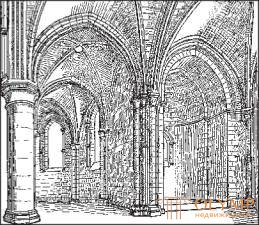
Crusades in the history of art are the reverse wave of the movement of Islam to the West, which was accomplished several centuries earlier. The kingdom of Jerusalem, of course, needed Christian churches, and just as it received its fallen device for the French model, so did French architecture as a prototype for its church architecture. To the French explorer Marquis de Vogue we owe the first information about the churches of the Holy Land. Not a single crusader thought of borrowing their architectural style from hated pagans. Restored wonderful temple of the Holy Sepulcher is an exception. Provencal and Burgundian influences affected first the Romanesque, then the early Gothic style of the Christian architecture of the Holy Land. In the style of primitive Gothic, with cross ribs and pointed arches, but also with windows ending at the top with a round arch, the Church of Sts. Destroyed during the capture of Jerusalem by Salah Addin in 1187 was built. John in Sebastia (Sevaste). In the same style built the Church of the Crusaders in Jerusalem with pointed arches (1140–1149) by a French architect; several ruins of early gothic churches survived in Jerusalem. In the high Gothic style of the XIII century, the churches of the main Christian stronghold in the East of Acre (Saint-Jean-d'Acres) were built, in the XIX century they were finally compared to the ground.

Fig. 316. Bypassing the choir of the church of sv. Sofia in Nicosia, Cyprus. According to Anlar
A large number of monuments survived on the island of Cyprus, where French architecture, since the conquest of the island by Richard the Lionheart (1191) and before the Genoese conquered it (1883), had at its disposal almost two centuries for the peaceful development under the cover of the Franco-Cypriot kingdom. The history of Cypriot art is dedicated to the excellent work of Anlar. The most remarkable of the early works of the French Gothic in Cyprus - the church of St.. Sofia in Nicosia (about 1200; fig. 316). Her plan is related to the plans of the Council of Sano and Paris. Its round pillars with octagonal bases are quite typical of early Gothic, but some of the capitals are still devoid of northern leafy ornaments. In 1250–1350 Cyprus has a more slender, more upward-looking and richer in western leafy forms, the French high Gothic, although significantly simplified in its main outlines. These churches often have only one nave, are deprived of a transept, and on the eastern side they end up with simple polygonal absides instead of more complex choir forms. The main building of this genus - originally crowned with two western towers and furnished with a richly dissected facade, the Catholic cathedral in Famagusta, whose windows with bindings and openwork pediments (vimpergami) are absolutely Gothic. That this style, which invaded the sphere of influence of Byzantine art, was also capable of original creativity, shows the second Greek cathedral of Famagusta, generally adopting its plan from the more ancient Catholic cathedral, but eliminating facade towers, which converted polygonal apses into semicircular and covered them instead of ribs. arches semi-domes. For the history of style variations, such transformations are extremely curious, but they were not always always viable. In Cyprus, they mark the beginning of the chaos of styles that prevailed in local art at the end of the 14th century.
It would be an ungrateful task for us to look for traces of sculpture and painting that decorated Frankish buildings of the XIII – XIV centuries in Cyprus. It should be noted only that while the western Gothic style prevailed here in architecture and plasticity, dominance in painting remained behind the Byzantine style. For construction and sculptural works of the master, of course, were discharged to the Levant from France. For paintings, however, resorted to the services of local natives - the Greeks, whose superiority in this area enjoyed universal acceptance, while the dawn of a new art rose over Italy. Before the rays of this dawn, the ghost of the "Byzantine Question" finally disappears from the history of art.
Что бы оставить комментарий войдите
Комментарии (0)